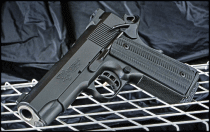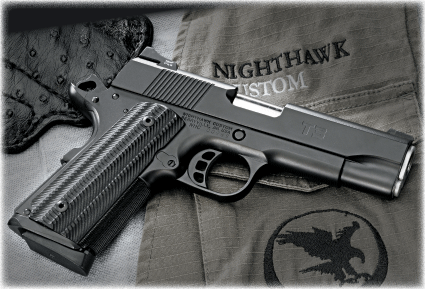 In this era of “reaching across the aisle,” we see compromise as a virtue (at least some of us). Some makers build small handguns of large caliber. This is often an exercise in frustration. I’m waiting for someone to make a small gun for a really hot cartridge and name it “Instant Flinch.” Now, that’s truth in advertising!
In this era of “reaching across the aisle,” we see compromise as a virtue (at least some of us). Some makers build small handguns of large caliber. This is often an exercise in frustration. I’m waiting for someone to make a small gun for a really hot cartridge and name it “Instant Flinch.” Now, that’s truth in advertising!
Others make one or another handgun as compact, sub-compact and micro. These aren’t bad guns, they’re just trying to make something you will carry, have with you when you need it and still have sufficient reliability, accuracy and power to get the job done, a daunting task.
When the group at Nighthawk Custom examined the best concealed carry pistol, another element was advanced: the ability to shoot the gun enough to become proficient with it.
Advertisement — Continue Reading Below
They started with the compact 1911 frame, rendered in steel. We consider it the Officers size frame, as it is the same dimensions. Shorter than the 1911 in Government and Commander trims, the Officers featured a 6-shot magazine. This was in the days that full-sized revolvers carried six rounds and compact revolvers only five.
The problem with the sub-Commander size guns was reliability. It wasn’t easy to get them to run. Once they did work, you had to stay on top of the maintenance or they’d quit. Besides, sight radius was short, and in a gunfight, less accuracy is not better. You were short one round of ammunition (standard 1911s of the period had 7-shot magazines). To deal with the working reliability and sight radius issues, Nighthawk elected to install a Commander-size upper on the Officers size frame. The grip frame is the hardest part of the pistol to conceal anyway.
Smaller Size
The original Commander was a standard size 1911-style frame made in aluminum alloy. The slide was shortened to accommodate the 4.25-inch barrel. The bushing is likewise shortened.
Advertisement — Continue Reading Below
Now they had a smaller gun that ran like a Commander. It also could be maintained like a Commander; the standard barrel, barrel bushing and short recoil spring guide allowed field stripping, no tools were required.
They blended an extended magazine well to the recessed bottom of the frame. The chute’s geometric angles are hand-cut. The length of the gripping surface of the pistol is only 0.13 of an inch less than a standard frame. The front of the frame is notched. Even if you use a magazine with a flat floorplate, you can reach the toe of the floorplate to pull a stuck magazine free.
It’s easier to shoot and it’s meant to be shot. Due to the propensity of guns with sharp protrusions and checkering to snag on coat linings, the mainspring housing has horizontal serrations (vertical serrations, while attractive, don’t help your grip control muzzle flip.) The Heinie Slant Pro is the rear sight, nicely snag free.
Advertisement — Continue Reading Below
The slide stop stud is shortened and the hole in the frame is countersunk. One can still press the slide stop out to field strip the pistol. The front sight is a Novak. The white ring around the tritium vial helps draw the eye to the front. The tritium vial at the base of the Heinie Slant Pro aperture has no such white ring. We don’t need to see the rear as precisely or quickly when distances and time are short.
Every part of the gun is blacked out except the barrel hood. The grips are made of G10. In the event that a cartridge lets go, say the case was double-charged with powder, the G10 will contain the blast allowing everything to go out the bottom through the magazine. Lumber usually gives way.
Less maintenance is required for the T3 than a classic compact, micro or Officers style 1911. The mid-length upper has a recoil spring that should be changed at 1500 rounds. For the smaller guns, you should really change recoil springs at 500 rounds. With the recoil spring on a full-length guide under the bushingless bull barrel of most small 1911-style guns, it becomes a challenge just to change the recoil spring. No problem here; field strip the gun, throw the old spring out and replace it.
Advertisement — Continue Reading Below
The T3 is one of Nighthawk’s best selling guns. They seldom have a completed T3 in the shop for very long. I can see why.
Carry Gear
Nighthawk sent along a sample of their holster line, the Companion, and a magazine pouch, both in mahogany. The Companion is a pancake-style holster with the concealed belt slots a distance in front of and behind the holster pouch. The holster had a hand-carved Nighthawk Custom logo on its face. As a concealment holster, it’s unlikely anyone will see the logo. It’s too bad. The job is well done.
The holster is a high ride, keeping the gun hidden and the bottom of the holster off the car seat. It tilts forward, not quite as much as the FBI tilt I like to use. The belt slots are concealed on the back of the holster. This, along with their Ray Baker-inspired location, keeps the holster close against your side.
Advertisement — Continue Reading Below
It rides so closely they engineered a safety guard/skin guard to keep that gun away from your hide. It also keeps the safety “on.” The magazine pouch likewise has a slight tilt to the front. This aids in concealment when sitting and feeds the magazine out when you need it quickly.
The T3 rode in the Companion and found the combination to be comfortable. Compared to some mouse guns I had been carrying, for testing of course, I found the T3 comforting as well. Knowing the .45 was on my belt made me not think about the .380 hanging in a holster around my neck…
Range Time
I took the little gun out to the range and did some work with it. Since it’s a full-steel gun and weighs around 34 ounces, it was no problem to shoot the gun quite a bit. I elected to stay away from +P ammo.
Advertisement — Continue Reading Below
I’ve fired +P from alloy frame 1911-style guns and from polymer guns that weighed quite a bit less than the T3. It wasn’t due to any perceived weakness in the gun or its parts. I decided to use this thing just like I’d purchased it to wear to save my life.
I’ve done the same thing with another compact service pistol and it’s lasted me quite well for more than 7 years. I’d expect no less from the T3. By keeping the same pressure ammo in its feedbag, I don’t have to estimate when it’s time to change recoil springs (and, eventually firing pin springs). I can go by straight round count.
The .45ACP has plenty of power, but nothing is 100 percent. Placement is the key, so training is order of the day. I found that Black Hills 230-grain FMJ, 185-grain Jacketed Hollow Point, and Fiocchi 230-grain FMJ were all reliable and shot right at point-of-aim. All were easily controlled.
Advertisement — Continue Reading Below
Starting backwards, I did handling drills for most of the early afternoon. The Nighthawk Companion holster is a worthy holster for the T3. I worked up to pairs in 1.5 seconds with the majority in the “V” from 7 yards. It wasn’t quite a cinch to make the 1.5 seconds single to the ocular cavity from 3 yards but it was doable.
Twenty-five yards saw pairs from the holster and from ready. This was a cinch. Like most of the really successful compact service guns, the T3 handles more like a full-size gun than it does a micro gun. Further distances don’t bother this gun. Close-up speed with accuracy is made easier with the Heinie Slant Pro Straight 8 sights.
The trigger was crisp, the gun was tight but reliable and the accuracy was there. Digging around in a few ammo cans, I found three other loads, all featuring 230-grain bullets that weren’t plus-pressure offerings.
Advertisement — Continue Reading Below
Federal 230-grain Hydra-Shok, a favorite in 1911-style pistols, shot a vertical stringing group, possibly due to my grip on the slightly short frame that measured 1.5 inches. Federal 230-grain Gold Medal Match hardball beat that group by a 0.25 of an inch.
Winchester 230-grain SXT Hollow Point threw one round higher than others in its small 1-inch cluster.
Final Notes
Nighthawk calls the T3 the “Ultimate Carry Pistol.” I doubt that it’s the first time the Officers frame has been mated to a Commander slide and barrel. Their reasoning was all right. It is a little short for my hand. At first, I didn’t shoot it the way I shoot the more conventional frame 1911. It felt a little funny. Certainly the accuracy was there when I was at distance and had time.
As I worked with the T3, the funny feeling went away. The frame length is very close to the Government due to the addition of the magazine chute. It was quite helpful on reloads as well. While it’s not belled out (and oversize) like competition models, it certainly makes that reload more positive. I didn’t get a magazine to stick in the gun, but I did check. I can reach the toe of the floorplate in front if the magazine does, for some reason, stick.
This all-steel pistol is easy to shoot well, it doesn’t beat you up when you shoot and it runs like a well-oiled machine. In that vein, I field stripped the T3 just to see how tough it would be. I used a bushing wrench just to ensure I didn’t let the recoil spring plug get away. After the T3 wears in a bit, I doubt that it’ll need that.
If you’re looking for a top-end concealed carry tool that will get you home at the end of the day, look no further. It’s no barbecue gun; the T3 is strictly business. It’ll get the job done.
Check out the The Double Agent by Nighthawk Custom!
For more information, contact: Nighthawk Custom, 1306 W Trimble, Dept CH, Berryville, AR 72616; 877-268-4867; www.nighthawkcustom.com.
























